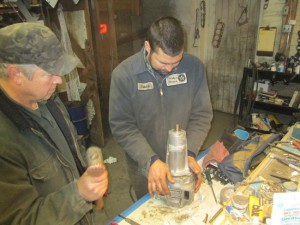I snapped this picture earlier today of a bench conference between Butch and Steve, with Patrick in the foreground. They’re looking for a set of hog-ring pliers to use on a set of TR6 seats that Steve is reupholstering. Patrick has just hauled the engine & transaxle out the red Mini. It’s a genuine Cooper “S” which was last registered in 1975 and displays an odometer reading of 32, 688. More on that story as it develops.
An ongoing project here has been the reconditioning of this C75B Shorrock supercharger, destined for Larry Perry’s MG TC. This wasn’t the first time to the Prom for this old girl. We pulled it down and cleaned it up, but a close inspection revealed the heavy touch of a previous unskilled hand with the result that while the vanes were individually within the range for end clearance of .010″, in practice we had a variance within the total operating plane of .010″ as well.
That adds up to zero, which is not enough for a precision mechanism like this. by machining the vane shaft and carefully adjusting shimming, Ken and Patrick were able to reduce the vane tolerance to .005″, a number we can live with.
For Ken Booth it’s a change of pace from the close tolerance prototyping work he spends most of his time doing. Look him up at KNB Manufacturing and Automation.
When we’re overhauling a Jaguar independent rear suspension it is our practice to resurface or replace the brake rotors. After washing them up we run ’em thru the bead blast cabinet and swizzle some paint on them with the result that they’re very spanky-looking when they’re done. It also aids in the inspection process.
These cracks which radiate from the apex of the brake caliper mounting bolt access holes were not at all apparent when we cleaned them up and could have led to a very nasty failure later on down the road. Most likely they were caused by excessive heat from the calipers which were well and truly seized, which is why we dropped the I.R.S. out of the car in the first place.
The Laws of Probability, as they apply to our work, state that if you only have one incident of damage every five thousand man-hours the amount of damage will be proportional to the likelihood that it will happen under the least favorable conditions. The broken heater fascia on the Austin Healey in the left hand picture cost us a $25.00 part and an hour’s time to fix it. The paint chip caused by a dropped wrench just behind the E-type hood catch on the driver’s side cost us a lot more. Since it’s much easier to own your mistakes than not, I sent the owner a check to cover the damage. He in turn endorsed it to my order, thereby taking it off his not insignificant bill.
Now that we got our steering side rods (as detailed last week) from Mike Buonanduci, the push is on to clear the Jaguar Mark IX Sedan from our work load. We really only have one work bay that will accomodate these behemouths and a Mark VI Bentley Standard Steel Saloon is currently waiting in the barn.










